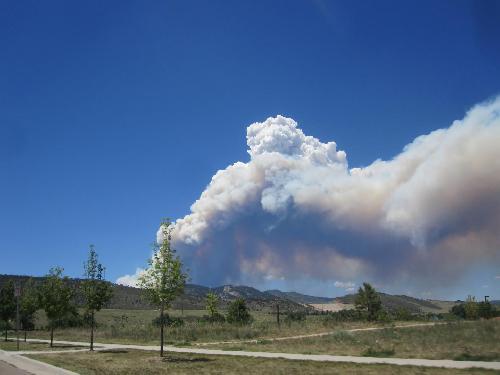FORT COLLINS, COLO. - For those living with the threat to life and property from wildfires, Colorado State University scientists have some more bad news: Wildfire smoke seems to elevate levels of ozone, a nasty air pollutant with proven adverse health effects.
The influence of wildfire smoke on ozone levels during summer months in the United States is not well understood. CSU atmospheric science researchers took a comprehensive, multi-year look at this secondary, insidious effect of raging wildfires. Published in Environmental Science and Technology, the new study quantifies what wildfire smoke does to ozone levels over a nearly 10-year span, integrating data from hundreds of monitoring sites dotting the country.
Across the U.S., ozone levels were higher on smoky days than on smoke-free days, according to the study led by Steven Brey, a graduate student working with Emily Fischer, assistant professor of atmospheric science in CSU's College of Engineering. According to Brey's analysis, a number of urban areas had smoke present during 10 percent to 20 percent of days when the standard Environmental Protection Agency ozone levels of 70 parts per billion (ppb) were exceeded. The EPA reset the ozone standard down from 75 ppb late last year, making it more stringent.
 The High Park Fire devastated more than 87,000 acres in the mountains west of Fort Collins, Colorado in 2012. This photo was taken June 9, 2012 at 12:30 p.m. Credit: Steven Brey/Colorado State University
The High Park Fire devastated more than 87,000 acres in the mountains west of Fort Collins, Colorado in 2012. This photo was taken June 9, 2012 at 12:30 p.m. Credit: Steven Brey/Colorado State University
Ozone is one of six "criteria pollutants" monitored by the EPA, and its adverse effects particularly on the young, elderly and people with asthma are well documented. "Good up high; bad nearby" is the EPA's description of ozone - the ozone layer of the Earth's atmosphere protects us from UV radiation from space, but down where we breathe, it damages lungs and destroys crops and ecosystems.
Typically, the effect of smoke on ozone levels is studied on a "plume-by-plume basis," Fischer explained. "A wildfire will be burning and someone will take an aircraft, like the NSF/NCAR C-130 or the NASA DC-8, fly around in it, and take measurements. What Steve did was take ground-level data ... to look nationwide, not just at one fire or one plume, but every ground site from 2005 to 2014."
Predicting the relationship of ozone and wildfire smoke requires an understanding of nonlinear ozone chemistry, which is tricky. In the past, some individually analyzed smoke plumes have been linked to a dramatic production of ozone, Fischer said, but others have seen ozone production actually suppressed within wildfire smoke.
Whether and how much ozone is produced is influenced by many fleeting factors. To make ozone, you need volatile organic compounds, nitrogen oxide and sunlight, interactions that can be determined by the amount of those chemicals in the air, how much sunlight is getting through the smoke, how hot the fire is burning, what is burning, and other variables. And smoke moves, disperses and becomes dilute over time. It's really hard to determine how all these factors work together to make, or not make, ozone.
Brey gathered data from 2005-2014 from the NOAA Hazard Mapping System, which uses satellites to visually track smoke plumes from areas of open burning. Armed with that data, Brey compared ozone levels on days when smoke was present with days when smoke wasn't present, and built an expected value of ozone levels for those days. Taken together, on the smoky days, ozone levels were higher.
That effect was marked around certain areas in particular: the Northeast corridor, Dallas, Houston, Atlanta, Birmingham, and Kansas City. "Which is not what you'd expect," Fischer said, because wildfires don't necessarily burn near cities. But the data indicate that as the smoke plumes travel, higher levels of ozone can be more often expected in urban than in rural areas.
That observation hints that wildfire smoke interacts with pollutants in urban air to create ozone. The data support the hypothesis, but a definitive claim can't be made yet.
With climate change predicted to increase overall temperatures and thus the intensity and frequency and wildfires, the study points to more questions about how smoke will affect ozone levels going forward.
Fischer and Brey will continue studying wildfire effects, in collaboration with other CSU researchers, with particular concern for human health effects.
source: Colorado State University